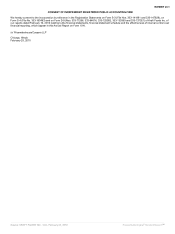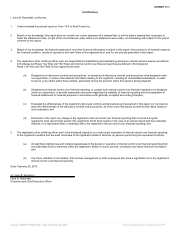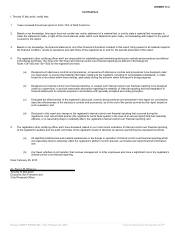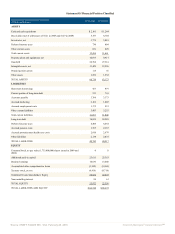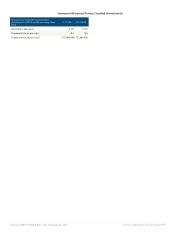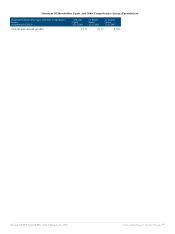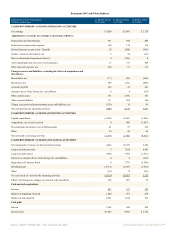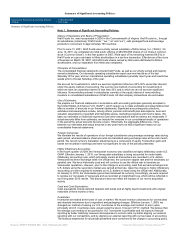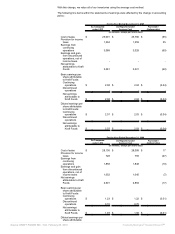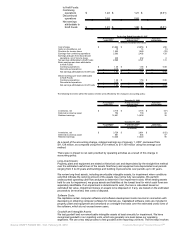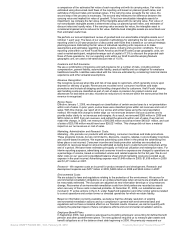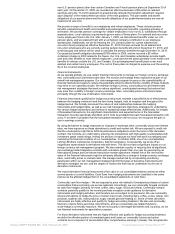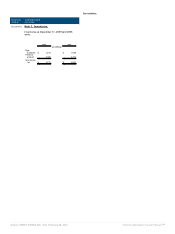Kraft 2009 Annual Report Download - page 195
Download and view the complete annual report
Please find page 195 of the 2009 Kraft annual report below. You can navigate through the pages in the report by either clicking on the pages listed below, or by using the keyword search tool below to find specific information within the annual report.
Summary of Significant Accounting Policies:
Summary of Significant Accounting Policies:
(USD $)
12 Months Ended
12/31/2009
Summary of Significant Accounting Policies:
Note 1. Summary of Significant Accounting Policies:
Nature of Operations and Basis of Presentation:
Kraft Foods Inc. was incorporated in 2000 in the Commonwealth of Virginia. Kraft Foods Inc., through
its subsidiaries (collectively “Kraft Foods,” “we,” “us” and “our”), sells packaged food and beverage
products to consumers in approximately 160 countries.
Prior to June 13, 2001, Kraft Foods was a wholly owned subsidiary of Altria Group, Inc. (“Altria”). On
June 13, 2001, we completed an initial public offering of 280,000,000 shares of our Class A common
stock (“Common Stock”). In the first quarter of 2007, Altria spun off its remaining interest (89.0%) in
Kraft Foods on a pro rata basis to Altria stockholders in a tax-free transaction. Effective as of the close
of business on March 30, 2007, all Kraft Foods shares owned by Altria were distributed to Altria’s
stockholders, and our separation from Altria was completed.
Principles of Consolidation:
The consolidated financial statements include Kraft Foods, as well as our wholly owned and majority
owned subsidiaries. Our domestic operating subsidiaries report year-end results as of the last
Saturday of the year, and our international operating subsidiaries generally report year-end results two
weeks prior to the last Saturday of the year.
We account for investments in which we exercise significant influence (20%-50% ownership interest)
under the equity method of accounting. We use the cost method of accounting for investments in
which we have an ownership interest of less than 20% and in which we do not exercise significant
influence. Noncontrolling interest in subsidiaries consists of the equity interest of noncontrolling
investors in consolidated subsidiaries of Kraft Foods. All intercompany transactions are eliminated.
Use of Estimates:
We prepare our financial statements in accordance with accounting principles generally accepted in
the United States of America (“U.S. GAAP”), which require us to make estimates and assumptions that
affect a number of amounts in our financial statements. Significant accounting policy elections,
estimates and assumptions include, among others, pension and benefit plan assumptions, lives and
valuation assumptions of goodwill and intangible assets, marketing programs and income taxes. We
base our estimates on historical experience and other assumptions that we believe are reasonable. If
actual amounts differ from estimates, we include the revisions in our consolidated results of operations
in the period the actual amounts become known. Historically, the aggregate differences, if any,
between our estimates and actual amounts in any year have not had a significant impact on our
consolidated financial statements.
Foreign Currencies:
We translate the results of operations of our foreign subsidiaries using average exchange rates during
each period, whereas balance sheet accounts are translated using exchange rates at the end of each
period. We record currency translation adjustments as a component of equity. Transaction gains and
losses are recorded in earnings and were not significant for any of the periods presented.
Highly Inflationary Accounting:
In the fourth quarter of 2009, the Venezuelan economy was classified as highly inflationary under U.S.
GAAP. Effective January 1, 2010, our Venezuelan subsidiary is being accounted for under highly
inflationary accounting rules, which principally means all transactions are recorded in U.S. dollars.
Venezuela has three exchange rates: the official rate, the consumer staples rate and the secondary (or
parallel) rate. We have historically used and will continue to use the official rate to translate our
Venezuelan operations. However, prior to this change in accounting, cash that we had exchanged into
U.S. dollars using the secondary market was carried at that rate. Upon the change to highly inflationary
accounting, we were required to translate our U.S. dollars on hand using the official rate. Additionally,
on January 8, 2010, the Venezuelan government devalued its currency. Accordingly, we were required
to revalue our net assets in Venezuela and we recorded an insignificant loss, which will be reflected in
our first quarter 2010 results. This disclosure does not reflect the impacts of our recent acquisition
activity.
Cash and Cash Equivalents:
Cash equivalents include demand deposits with banks and all highly liquid investments with original
maturities of three months or less.
Inventories:
Inventories are stated at the lower of cost or market. We record inventory allowances for overstocked
and obsolete inventories due to ingredient and packaging changes. Effective January 1, 2009, we
changed our method of valuing our U.S. inventories to the average cost method. In prior years,
principally all U.S. inventories were valued using the last-in, first-out (“LIFO”) method. We believe that
the average cost method of accounting for U.S. inventories is preferable and will improve financial
reporting by better matching revenues and expenses to current costs, by better aligning our external
reporting with our competitors, and by aligning our external reporting with our tax basis of accounting.
The financial statements for all periods presented were conformed to the change in accounting policy.
Source: KRAFT FOODS INC, 10-K, February 25, 2010 Powered by Morningstar® Document Research℠


